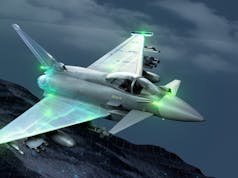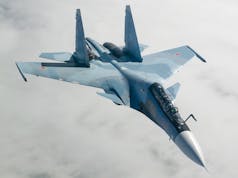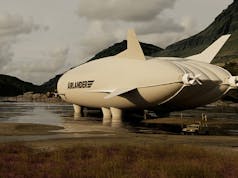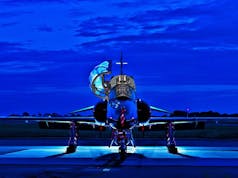Ukraine and Sweden have signed a landmark defence cooperation agreement that clears the way for Kyiv to purchase between 100 and 150 Saab Gripen multirole fighter aircraft.
The announcement was made during a joint press conference at Saab’s headquarters in Linköping, where President Volodymyr Zelenskyy and Swedish Prime Minister Ulf Kristersson stood before a Gripen E aircraft to unveil the deal.
The agreement marks the first time a NATO member has offered to supply Ukraine with a large fleet of modern combat jets, a move both leaders described as transformative for European security. “This is the beginning of a long journey, but it takes us one step closer to a major export deal for Saab and Sweden and Ukraine,” Kristersson said, highlighting the deal’s long-term industrial and strategic implications.
For Sweden, the agreement represents what could become its largest ever defence export. For Ukraine, it promises to significantly modernise an air force still reliant on ageing Soviet-era aircraft. Zelenskyy said on X, “We are opening an entirely new and truly meaningful chapter in our relations, relations between Ukraine and Sweden, and more broadly, overall security relations in Europe. These are strong aviation platforms capable of performing a wide range of missions.”
Today, we are opening an entirely new and truly meaningful chapter in our relations—relations between Ukraine and Sweden, and more broadly, overall security relations in Europe.
Today, we have the first document signed between our countries, paving the way for Ukraine to acquire… pic.twitter.com/y23ouunOyY
— Volodymyr Zelenskyy / Володимир Зеленський (@ZelenskyyUa) October 22, 2025
The Saab Gripen, a fourth-generation light single-engine supersonic fighter, is known for its versatility and relatively low cost compared to fifth-generation aircraft such as the F-35. It can conduct air-to-air, air-to-ground and reconnaissance missions, making it well suited to Ukraine’s evolving air combat requirements.
Sweden has already supplied Ukraine with armoured vehicles, artillery systems, and ASC 890 radar reconnaissance aircraft, known internationally as the Saab Erieye. The Gripen deal extends that cooperation into advanced aviation, establishing a long-term industrial partnership focused on strengthening Ukraine’s air defence capabilities.
Exact terms, delivery schedules and costs are still to be finalised, but both governments indicated the agreement could redefine European air power and signal a new phase of defence integration between Sweden, now a NATO member, and Ukraine.














Also hugely good news for the British companies that make parts for the Gripen.
Presumably they get some used ones pretty quickly and Sweden gets new ones from the line to backfill.
Very interesting to see how these relatively cheap jets perform in combat. Key is they are easy to maintain and rugged.
That is where UK needs to adjust its mindset and have some 2nd tier platforms – like RN has T31. There are situations where an F35 or Typhoon is too much plane.
I get that RAF has limited budgets and it make sense to have mass of Typhoon and F35B before broadening out.
The trend was fixed many years back when “we” had multiple aircraft for different roles the Tornado (MRCA) was envisaged to combine many of those roles into one airframe. Typhoon has effectively slid into Tornado’s shoes whilst F35B has been rather lacking in numbers that were envisaged to replace certain Tornado and Harrier roles.
We lost Tornado, Harrier, Buccaneer, Jaguar and hundreds of airframes in persuit of “Multi Role”.
Jack of all trades thinly spread.
That is very true.
It was also a time of budget cuts and lots of platforms reaching EoL and no money for another upgrade cycle.
So having Typhoon, A400M & Chinook in numbers took priority.
“In Numbers” !
Could the Hawk replacement be a scaled-down Gripen, allowing for milk run operations and some combat support beyond its training role, with a heavier payload than Hawk? This new plane could also operate as a drone mothership, controlling observations. A smaller Gripen size would also be more representative of frontline aircraft.
Trouble is, the unit cost of Gripen has risen to $85m for the E version. The RAF is going in the opposite direction with Tempest – bigger, longer range.
The light attack role once carried out by small trainer aircraft will almost certainly be done by UCAVs. How survivable in contested airspace such a plane would be is unknown but Ukraine war suggests not very.
Yeah I think we need to get into the mindset of first asking “can a drone do that job?” if the answer is yes then there’s very little chance we’ll buy the manned option.
There’s also very little chance we’d buy the unmanned option but that’s beside the point.
On balance I agree, strategically a Gripen E is far less useful to us than it is to front line Countries where such an aircraft could indeed be crucial in terms of mass and availability with quick turn around and less than perfect operating environments. Generally I think those front line Countries in a conflict are best left to deal with the situation Gripen is best suited for, while we and others supply the ‘bigger picture’ more calculating support operating from further back. Indeed unless we are going to buy another 40 to 50 Typhoons it’s not even a real option to do otherwise. I think they are saving money on Typhoon now for Tempest later, either way no order for Typhoons of that size is going to happen sadly.
For now I agree the plan for unmanned is going to take precedence for frontline and more risky strike and probably defence against drones and cruise missiles too with as happened with the Typhoons in Irans first barrage against Israel forming a second line of defence. Of course as others have raised how effective will unmanned systems be in a truly highly contested electronic warfare environment. All eggs in one basket would be very worrying so hope there is a semblance of a plan B or at the very least advances in making such unmanned platforms extremely resistant to interference are progressing well, but still a concern.
Depends on DAS how survivable they are and what they are up against….
The cost of buying is one thing the cost of flying is quite another…
The Gripen F would make for a very significant advanced trainer. As it has all the avionic systems that a Gen 4.5 jet has along with some outstanding Electronic Warfare options. If the Gripen would make a decent advanced trainer, then equally a Typhoon two seater would be more in line with the RAF’s in-service jets, as well as providing logistical and maintenance commonality.
However, if we wanted to make sure the advanced trainer was more representative of Gen 5 jets, which could also do a bit of Gen 6. South Korea are looking at a two seater version of the KF21. Though I’m not sure if this is for the existing airframe or the Block 2 airframe with the internal weapons bays. A Block 2 version would be more representative of the F35A, along with some of its capabilities.
In my view whatever replaces Hawk reall should have a strong secondary combat capability if that is at all possible. This may be as a drone controller or other new gen capability than actual traditional frontline support but some e tra capability can add some mass to our limited frontline resources. A quick response easy maintenance platform taking a leaf out of Gripen’s book would certainly be very useful once Tempest enters service and Typhoons start to leave service. Tempest will be too valuable to do mundane stuff like a typhoon is expected to carry out in a routine manner that in itself is sometimes overkill for such an aircraft.
In numbers? 🤣
I would say we lost Tornado to savings.. there is no reason why the RAF could not still be running 4-6 squadrons of tornadoes, the frames only had half there flight hours used up and there were a lot of tornadoes.
Yes, we lost them all to Savings. Getting shot of Tornado was especially shockingly bad.
Given the spares issues other European users have had by the end of service life for their Tornado’s I’d be surprised if the RAF ones weren’t having issues by now if they had beeen retained.
Spares sustainment was shut down and the stocks allowed to run down some time ago.
The other nations will be using parts from ex RAF etc to keep flying.
Same issue as Concorde / Vulcan at some point you have got to call it a day as sustaining the parts tail is a big cost of the fleet.
Yep but the RAF has 380 of the things each with only half its flight hours. It finished production in 1998.. it would only have needed to sustain about 70 working to maintain 4 squadrons.. that’s 310 to pull apart for spare parts.. if Germany could keep a few squadrons running until 2030 so could the UK.. one of the key arguments that are used about numbers of RAF squadrons is the pure capital cost of even 4th generation fast jets.. 4 squadrons worth is 7 billion pounds… we could have had 4 squadrons worth still running without those capital costs.. we could have not had to run the typhoon airframes so hot and preserved their hours for in the 2030s…
Well we had 380 to have 4 squadrons running we would have only needed 70 running.. if Germany can keep squadrons running to 2030 so could we.. remember one of the key arguments about fast jet squadrons is the pure capital costs of fast jets.. 70 fast jets as 7 billion.. we essentially scrapped well over 300 hundred fast jets with half their life life… that’s a 30 billion capital investment to buy now.
I think you are underestimating the costs of sustaining them.
Germany sustain them for the nuclear role.
If anything else was nuclear certified they would have been binned ages ago.
That 2nd tier will almost certainly be drones rather than manned aircraft, though.
TBH if/when the navy finally get some combat drones operating from the carriers, there’s no reason the RAF couldn’t order additional units too.
I hope for some orders of something useful!
Be they drones or aircraft.
ATM the drones thing is more a hope and aspiration than a tested platform suitable for a contested environment.
Agreed.
I toi believe 2 Tier is the only way to get more mass.
Is that after Kier has had a few good lunches?
Yes, him as well haha.
Great news for Ukraine. Great little aircraft and i believe they can take off from roads, which will make it easier to disperse
If they get the full electronic fit they will have a savagely effective aircraft superior to any standard adversary. Equally the quest arises will they be fitted with a Meteor. If so the combination will be very scary for Russia who are already struggling with the performance and limited weaponry on F-16s. Will these Gripens be able to mount ASRAAMS at some point, can’t find anything saying they can be used by them but would be extremely useful against drones and cruise missiles, just as they are now used effectively through Raven. Surely work to incorporate them will take place, unless certainly they can get shed loads of cheapish sidewinders from the US but as we are all paying for these US arms and what with their compromised future availability dependent on Trump’s Peace prize ambitions getting them on Gripens seems to be a must do. India is trying to get them on its Sukhois so surely this would be a snip compared to that.
Just got a proactive message from wiki search assist which says ASRAAM is integrated with Gripen. That’s handy on both counts.
Ukraine’s deal calls for an in-service date of 2026. Which I believe can’t be totally met by the newer Gripen E and F. So perhaps to meet this in service date, as has been mooted in the past, Ukraine will likely get a few Gripen C/Ds as well, to help speed up the integration of using/flying Gripen. But I believe looking at all the press, that there is consensus that Ukraine wants at least 100 Gripen Es along with some additional Fs. If so, this will be the biggest order Saab has had for Gripen. I definitely believe this is the right choice for Ukraine.
The reasons for this are that the Gripen is a very capable 4/4.5Gen (C/D, E/F) fighter and designed to be operated and maintained in austere conditions, for example at a forward operating area that is usually a public road. The close coupled canard and delta wing, gives it a pretty decent short take-off and landing (STOL) capability. Which for Ukraine will be ideal to match their wartime conditions. Where they have to move their operations almost daily.
There is a big question of what the Gripen E especially will be armed with, but also fitted out avionic wise. As this aircraft will have the very latest avionics that most NATO fighters have. The Raven AESA radar in particular has history with the Typhoon’s ECRS AESA. The E/F version also introduces a new helmet mounted display (HMD) similar to Typhoon’s Striker Helmet. But its the electronic warfare capability that will be most telling. If Ukarine’s Gripen come with this, this will be a significant step change in capability that will face Russia. So not only the aircraft’s active jamming capabilities, but Gripen also now uses Leonardo’s Britecloud expendable active decoy. Which can be used to defend the aircraft or offensively to seriously confuse Russian radars.
Perhaps the biggest game changer would be if Ukriane’s Gripen E gets Meteor. At the moment Ukraine’s donated F16s are causing havoc for the Russian Air Force. But a Gripen E, with its Raven radar and Meteor, will be a game changer. As it will put Ukraine on an even par with the Russian Su35, in reality it will probably surpass it.
I can’t emphasize enough of what a difference the Gripen E/F will make to Ukraine’s defensive effort, but also allows them to consider significant offensive options. Especially when working in collaboration with the Erieyes they now have.
Saab have also recently been looking at replace the current US supplied GE F414 engine, with the latest version of the EJ200. The latest spec of EJ200 has significantly more performance than the F414 and won’t be subject to US mood swings.
Only issue is that if one comes down Russia and China get to see an EJ200 in the flesh.
There’s always that risk.
And also running costs. A quick Google: “The Eurofighter Typhoon has significantly higher running costs than the Saab Gripen, with figures around $60,000 per flight hour for the Typhoon compared to about $4,700 per flight hour for the Gripen E.” I image that the running costs for a larger Tempest fighter will be significantly more than the Eurofighter even if that brings advantages of longer range, less reliance on tankers, stealth, more advanced technologies and better sensors, etc.
I’m sure that those prices are not quite comparable. But an order of magnitude or even close is massive.
However, I’d be very wary of allowing F35B numbers to be eroded in favour of something like Grippen as we havn’t reached critical mass on that which I would put at the 72 before RAF started with the ALPHA nonsense.
I can see a role for a fleet of Grippen in a swing role between trainer and Tier2 mission profiles. We need pilots to be enthused and get air time and indeed for reserve pilots to remain current on some kind of fighter. Flyable hours on the Typhoon and F35 are low and the fleets smaller so something has to give to get the pilot numbers and currency up.
Exactly, Gripen offers amazing bang for the buck and it’s somewhat belated sales boost is because Countries especially those with limited resources are standing up and noticing what a good package it is, seeing especially in Ukraine the balance of cost/capability, not just initially but over but full life, gives rather more than they lose for the available resources. Fact is its electronics package is collectively damn good and why it has achieved very creditable success in Red Flag events against non stealth opponents in particular.
However to get the best from it it will need the weapons, if it got Taurus (which it is capable of) that would be a serious problem for Russia. I assume they will rig it for Storm Shadow which will likely enhance use of that weapon over the present mash up. Equally its ability to operate seamlessly with their Swedish Saab 340s is going to be very useful no doubt.
slava ukraini
Interesting that the US has lost out on a big export due probably to its foreign policy.
And long may that continue. Its better for all of Europe, UK included, that kit is developed in Europe. Better for sustainability, independence from erratic US policy, keeping home grown skills alive, keeping money within the European economy, the positives are overwhelming. Let’s hope Trump has achieved one positive in his presidency by finally opening some European eyes.
Totally agree but let’s hope eyes stay open even when (hopefully) he has gone. As the US declines it’s hardly likely this sort of politics is simply going to disappear a new potentially even more dangerous protagonist could arise even more anti anyone else except powerful dictators.
A good choice for Ukraine. There has been much talk of the plane geing upgraded with RR power plants to improve performance and ditch the US made ones to avoid US export controls. I hope RR is given this work and Ukraine has RR powered jets.
Think I read elsewhere the first delivery would be 3 years+ away.